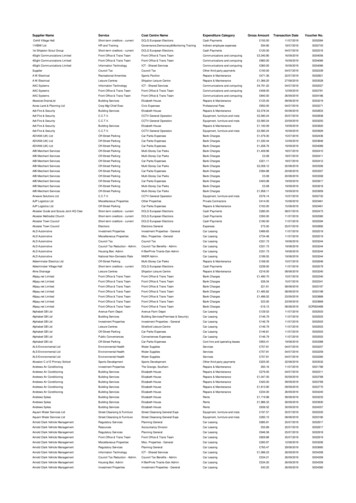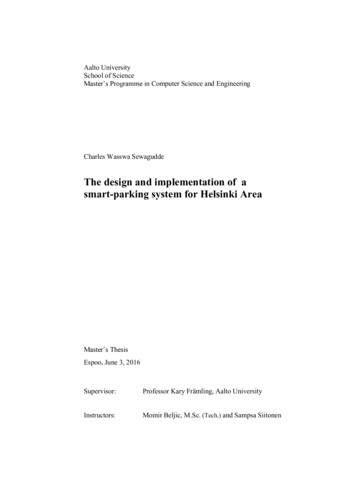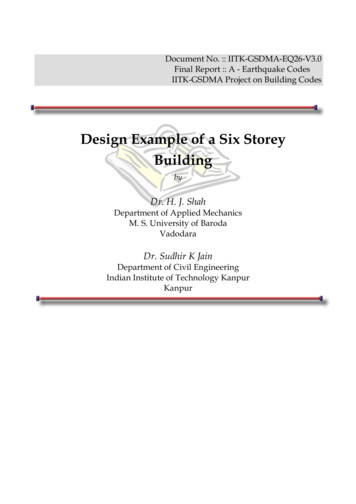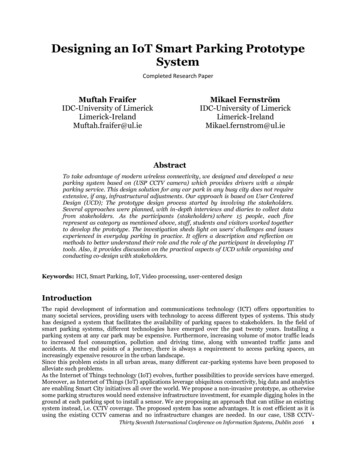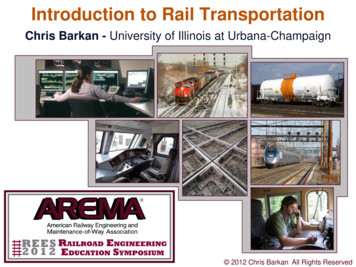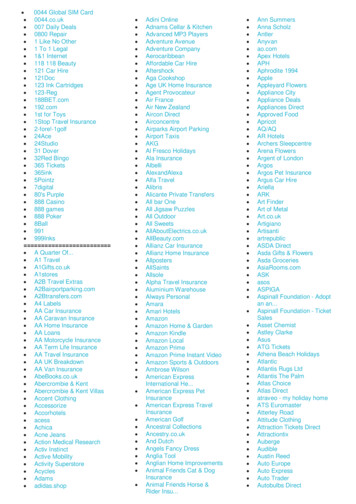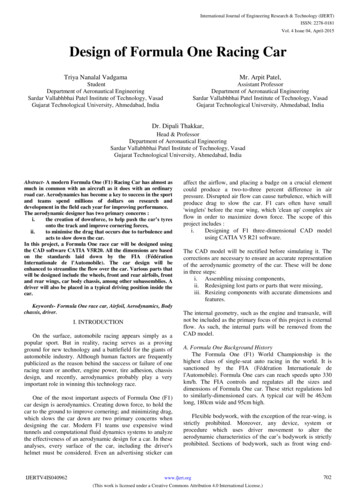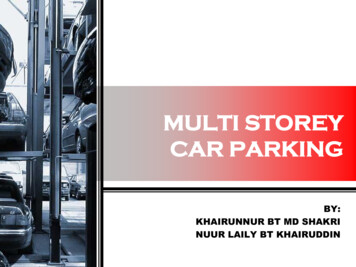
Transcription
MULTI STOREYCAR PARKINGBY:KHAIRUNNUR BT MD SHAKRINUUR LAILY BT KHAIRUDDIN
MULTI STOREY CAR PARKING A multi-storey car park or a parkinggarage is a building (or part thereof)which is designed specifically to be forautomobile parking and where thereare a number of floors or levels onwhich parking takes place It is essentially a stacked parking lot It is limited to 5 till 6 stories with thetotal capacity up to 500 cars per lot Apply multiple access and exit systemto avoid traffic congestion in and out
MULTI STOREY CAR PARKING Criteria for the quality multi storey car parks are;- safety in use- clear visibility- parking-space marking to enable drivers toremember the location of their vehicles- integration into the context of town planning- clear views to the outside- good natural lighting and ventilation
MULTI STOREY CAR PARKINGGENERAL GUIDELINES Basement parking Appropriate for residential area, apartment, commercial complex, office complex and forarea around airport that has building high control limit Podium parking For medium and high density residential area, plus, office complex. Ground level untillevel 4 are used for the parking area, while residential unitS, office and other functionalspaces are located above the parking level Independent building for multi storey car parking For all building types that have large and adequate area for parking, such as low costapartment, trade and city center, park and ride system at LRT station or railway station,bus station, institution, sport complex and mosque Normally built separately if the building function is different Roof top parking Appropriate for shopping complex (less that 5 stories) because it saves cost comparedto basement parkingSource: Department of Town and Country Planning
MULTI STOREY CAR ARKINGclearwaysystemCONVENTIONALPARKING / ight
CONVENTIONAL PARKINGRAMP SYSTEM1)Clearway parking Interfloor travel path completely separatedfrom potentially conflicting parking –unparking movements Provide safest movement with least delay Preferred for self park design Feasible for small garage sitesclearway ramp system
RAMP SYSTEM2) Adjacent parking Part or all of ramp travel is performed onaccess aisles Requires less area per parking stall Twofold use of travel pathsAdjacent-parking ramp systems Feasible for smaller land parcel More susceptible to traffic movement delays Has potential in causing accident
RAMP DESIGN1)Opposed ramp design Vehicles rotate in the same directionUp and down ramps in oppositedirectionRequired ramp surfaces to be opposedThe operation is safer 2) Parallel opposed ramp designUp and down ramp slope in the samedirectionRamp surfaces are parallelVehicles must rotate in oppositedirectionCheaper to constructparallel ramp design
Parking layoutPARALLEL parallel parking requires experience, confidence, and patienceParking spaces (min );7.5 meters long2.75 meters wide.Advantages Works well in extremely narrow, linear spaces Requires minimum pavement areaDisadvantages Difficult maneuvering for most drivers Less than ideal visibility of adjacent traffic Inefficient use of on-street space
Angle 90 effective in low turnover rate or long term parking areas,the perpendicular, or 90 degree parking configuration isthe most efficient and economical since it accommodatesthe most vehicles per linear meter. Standard dimensions for this configuration are:DescriptionDimensionParking space width2.75 metersParking space length6 metersDriving aisle width (2-way)7 metersTwo rows plus aisle width19 meters Vvehicles per 100 linear meter double row 82Degree Parking Dimensions and Geometry
Angle 90 Advantages Works well with either one- or two-wayaisles Handles the most vehicles per squaremeter of pavement Handles most vehicles per linear meterDisadvantages Requires widest area Difficult maneuvering for some drivers Two-way traffic can create somevisibility problems90 Degree Parking Pattern
Angle 60 - ideal for a fast turnover rate or predominantly short termuse- often offset by difficulties of inefficient circulation patternsand one-way aisles Standard dimensions for this configuration are:Description DimensionParking space widthParking space lengthDriving aisle width (1-way)Two rows plus aisle widthVehicles per 100 linear meter double row2.75 meters6 meters5.5 meters16.5 meters65.660 Degree Parking Dimensions andGeometry
Angle 60 Advantages in and out of parking spaces Good visibility Lends itself to either one-or two-way aisles Most common short term parking configurationDisadvantages Requires more pavement per vehicle thanperpendicular configuration Handles less vehicles per linear meter60 Degree Parking One-way and Two-wayPatterns
Angle 45 The 45 degree angled parking configurationdisplays similar benefits and limitations asthe 60 degree.Standard dimensions for this configuration are:Description DimensionParking space width2.75metersParking space length6 metersDriving aisle width (1-way)4.5 metersTwo rows plus aisle width14 metersVehicles per 100 linear meter double row 52.545 Degree Parking Dimensionsand Geometry
Angle 45 Advantages Reduced width requirements for layoutEasy maneuvering in and out of parkingspacesGood visibility to the rearDisadvantages Doesn't work well with two-way aislesRequires more pavement per vehiclethan perpendicular parking configuration45 Degree Parking Pattern
Angle 30 Standard dimensions for this configuration are:DescriptionDimensionParking space width2.75 metersParking space length6 metersDriving aisle width (1-way)7 metersTwo rows plus aisle width19 metersVehicles per 100 linear meter double row 39.430 Degree Parking Dimensionsand Geometry
Angle 30 Advantages Easy parkingReduced width requirements for layoutDisadvantages Requires the most pavement per vehicleDoesn't work well with two-way aisles30 Degree Parking Pattern
Types of ramp1) Straight ramp Usually rectangular shaped with ramp wellalong the structure’s longer side dimensionmore horizontal distance is required to satisfyramp grade criteria than accommodatevehicular movement between ramp endsRequires less floor area and simple toconstructEconomical space on lot that is long andnarrow
Cause difficulties to get on and off straight ramp (Sharp turn) Having two ways circulation lanes on parking floor may be hazardous Up and down circulation lanes intersect on the parking floor unless thefloor area is so large that each circulation can be kept within its own halfon one-way lanes
curve ramp Single surfaces that permits vehicles to travel on acontinuous helical path between parking levels ntrance and exit in the side Opposite side of ramp oil Directly above each other on succeeding floor Should be clearway type Continuous- 360º of rotation between two parkinglevels Located near corners of rectangular structure tominimize floor space loss but required more spacethan straight ramp.(fit narrow site but waste morespaces)
costly to constructOffer better traffic operation by providinggradual turning as compared to sharp turningmovement usually required at ends of straightrampSuper elevation at ends of straight rampcreate undesirable wrapping of floor areasNo crossing of up and down traffic, even atparking floor connectionEach traffic stream confined to its own rampall the way from the top to bottom of thebuildingDiameter of ramp is controlled by requiredturning radiuS (min 45 ft)Driver have a clear view each way even thereis a crossing of traffic at each parking floorFunctional plan for twin-spiralgarage
FLOOR SYSTEM1) SPLIT-LEVEL OR STAGGEREDFLOOR SYSTEMS Floor levels in one section is staggeredvertically by one half story from those inadjacent sectionsApplicable to small, high-cost sites wheremaximum use of space must be achievedAdvantages Construction is relatively simpleThe design fits well on rectangular sitesEfficient in terms of floor space per vehicleparking stallDisadvantages Frequent conflicts may arise betweencirculating traffic and parking and un-parkingvehiclesSplit system
Two-way staggered-floor ramp systemThis staggered-floor system provides parkingon level floors and desirable one-way trafficflow- COMMON TYPETandem staggered-floor ramp systemThree-level staggered-floor ramp system
FLOOR SYSTEM2) SLOPING-FLOOR SYSTEMS Consist of sloping levels (full widthramp/continuous ramp)Contains two adjacent parking modulestilted in opposite directionsWell-suited to self-park operationsAdvantages The relatively flat floor slope permitscomfortable parking and pedestrian walking Each entering customer has an opportunityto park in the first available space as parkingis adjacent to the interfloor circulationsystem Floor-to-floor travel distance is greater insloping-floor garages than in other types oframp garagesPlan view of sloping floor systemsDisadvantages Cause congestion during peak out-boundmovementsBasic sloping-floor concept
Sloping –floor system withcrossover ramp of mid pointDouble sloping-floor systemwith midpoint crossover
AUTOMATED PARKING Automated parking is a method ofautomatically parking and retrieving carstypically using a computerised system ofpallets, lifts and carriers Most suitable on expensive sites and whereland is very limited- too small for economicaldevelopment with a ramp parking advantages :- increase capacity ; high space utilizationdue to lower ceiling height, dense parking,and reduce space width- no ventilation or HVAC required; savingutility costs- eliminates stairs, elevators and fire exits- enhance safety and security- typically requires less building volume andless ground area than a conventional facilitywith the same capacity
AUTOMATED PARKING Disadvantages :- cost ; operation and maintenance Many structural and functional types ofautomated mechanical systems exist, suchas :- underground systems as part of thebuilding foundation- above grade where they can matchneighboring buildings in architecturalappearance
STANDARD AND REGULATIONRamp break over angle Measure ability of the car to break over the steepramp either climbing or descending without scrapping(Min 10º) Can be altered through design techniques Transitional blend top and bottom of ramps composedof two or more break point can multiply the steepnesswith workable break angles beyond the normalcapacities of cars or driver Having pad of asphalt or concrete each side of breakpoint so that the cars having low break over angle cannegotiate potential critical points without scrappingAngle of approachesAngle of departure Min 10º To reduce incident of tailpipe and rear bumpingdraggingAngle of approaches Min 15 ºAngle of departure
Ramp slopes Max 15%For slopes over 10%, transition at least 8 feet long should be provided at eachend of the ramp at one half the slope of the ramp itselfRamp grades transition Min 12 foot long 1/2 of ramp gradeRamp widthOne way straight rampTwo way straight rampCircular ramp-min 12 feetmin 22 feetmin 14-18 feetRamp radius Single lane helical rampmin 32 -37 feetMust kept min to conserve space and reduce travel distanceVery sharp can cause dizzyRamp turn super elevation ½ inch/foot of ramp width at sharpest turningRamp curves not too steeplya) Slow driver- difficult to keep way from inside edge of ramp pavementb) Fast driver- encourage to speed greater than conditions of grade andsight distance safety permitSTANDARDANDREGULATION
STANDARDANDREGULATIONDriveway exitsa) Ramp driveway exit rising up to public sidewalk have transition section min 16 feet long at almost level beforeintersecting the sidewalk Prevent hood of the car from obscuring the driver’s view of pedestrianson walkb) Property line wall Must not interfere with the driver’s view of pedestrian on public sidewalk. If exit driveway is parallel and adjacent to the property line that extendsall the way to side walk, edge of the driveway should physicallyestablish by curbing or railing. min 6 feet from the wall.Ramp grades Computed by Max ramp grades :a) self park design- not exceed 15 %- not exceed than 10% if had a pedestrian walkway on vehiclesrampb)sloping floor self park design- ramp grades max 4%- angle parking 60º-minimizes gravity roll back of vehicles:floor to floor height x 100Ramp length
Ramp appearanceArchitectural and optical effect Ramp wall- Painted with stripes contrasting to wall color- Parallel to ramp surfaces or at steeper angles- Use paint marking in between vertical column and travel way- Built structural features with architectural lines parallel or perpendicular to ramp surfaces Ramp structures- Open ; to provide sight distance and reduce closed in impression Ramp illumination- Wall opening are restricted-distract the driver’s view- Artificial lighting should take form of diffused illumination- Reflector should pointed away from the direction of travelSigns and Wayfinding Color-coding, numbering, visual cues, music, and even machines for marking your ticket with your exact locationto locate your car for easy retrieval Locate signs in areas where driver can read in a timely fashion Clear, simple, and direct messages Floor coding can be useful Signage should locate all major internal pedestrian access points as well as external major roads and buildings
Vehicle controlFee collection Fixed or variable charged pay on exitBarrier capacity 2 barrier types available- Rising arm- Rising kerb Entry barrier Exit barrier400 vehicles/hour250 vehicles/hourLighting Services illumination for public should be (lux);Parking areasDrivewaysRampsRoofEntrance and exit20507020150Interior view of multi storey car parking
Security and safety Open, glass stairwells and glass-backed elevators Security devices- video, audio and emergency buttons that call into the booth or localpolice station- Public telephones Eliminate potential hiding places, such as under open stairs Handicap accessibility with vehicles close to stair and elevator coreshave a direct path to key movement patterns of the garage ventilation- avoid carbon monoxide build-up, designed adequate air flow for throughmechanical and/or natural Non-slip floor surface- ensure safety of movement of the man and automobile Energy efficiency in lighting- balance between day lighting, interior lighting and exterior controlespecially on the exterior design of the façade while providing adequatelighting within- Lights should be vandal resistant and easy to maintain.
Fire and precautionStructural fire resistance Use non-combustible materials in the construction with structural fire requirement 1 hour inspecific restricted circumstances requirement for structural fire requirement may be waivedfor building less than 15.2m highEg: Cast in place concrete, pre-cast concrete and structural steelMeans of escape All parking spaces within 45.7 m of escape stairway having 1 hour fire requirementFire precaution Have adequate- fire bridge access- Dry rising main- Fire points
apartment, trade and city center, park and ride system at LRT station or railway station, bus station, institution, sport complex and mosque Normally built separately if the building function is different Roof top parking Appropriate for shopping complex (less that 5 st
